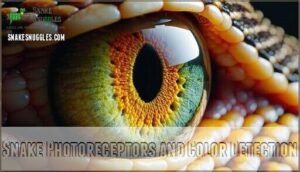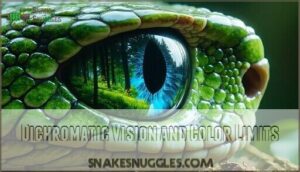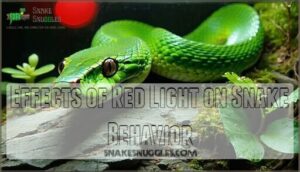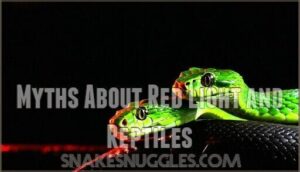This site is supported by our readers. We may earn a commission, at no cost to you, if you purchase through links.

This means red bulbs aren’t "invisible" to your snake as many keepers believe. Red light can actually disrupt their natural sleep cycles, increase stress responses, and confuse day-night rhythms, particularly in nocturnal species with rod-heavy retinas.
The lighting choices you make for your snake’s enclosure have more impact on their health than most realize.
Table Of Contents
Key Takeaways
- You’re wrong if you think red bulbs are invisible to snakes—most species can see red light through their cone photoreceptors, though it appears dimmer than it does to humans.
- Red lighting disrupts your snake’s natural sleep cycles and increases stress levels, since nocturnal species need complete darkness to regulate their circadian rhythms properly.
- Your snake has dichromatic vision that primarily detects blue and green wavelengths, making them struggle with red-green discrimination compared to humans’ trichromatic vision.
- You’ll get better results using ceramic heat emitters or deep heat projectors for nighttime warmth instead of red bulbs, as these provide heat without visible light that could disturb your pet’s natural behavior patterns.
Can Snakes See Red Light?
You might think red lights are invisible to your snake, but this common belief is actually wrong.
Most snakes can see red light because they possess cone photoreceptors that detect wavelengths across the visible spectrum, including the longer red wavelengths.
Snake Eye Structure and Color Vision
Your snake’s eyes work differently than yours. Snake retinal structure contains specialized photoreceptor diversity, including rods for light sensitivity and cone opsins for color perception.
Most reptiles have dichromatic vision, seeing two primary colors instead of three like humans. This unique setup affects how snakes process visual information and impacts reptile care decisions you’ll make for best reptile health.
Red Light Visibility for Snakes
Recent studies reveal that red light perception in reptiles isn’t as straightforward as many believe. Your snake’s photoreceptors can detect red wavelengths, though they appear much dimmer than to humans. This creates potential for nocturnal disruption in reptile care.
Consider these behavioral effects:
- Altered sleep patterns disrupting reptile health
- Increased stress responses in nocturnal reptiles
- Confusion between day/night cycles
- Reduced feeding behaviors
- Enhanced hiding tendencies
While infrared sensing differs from visual perception, red bulbs aren’t invisible to most reptile species.
Differences Between Diurnal and Nocturnal Species
When comparing day and night hunters, you’ll notice striking differences in their visual systems. Diurnal species possess pure-cone retinas for sharp color perception, while nocturnal reptiles have 90% rod composition for enhanced light sensitivity. These evolutionary adaptations affect how each group reacts to red light exposure and UVB requirements.
| Feature | Diurnal Species | Nocturnal Species |
|---|---|---|
| Retinal Composition | Nearly all cones | 90% rods, 10% cones |
| Light Sensitivity | Lower sensitivity | High sensitivity |
| Activity Patterns | Daylight hunting | Night hunting |
How Snake Vision Differs From Humans
You’ve got dichromatic vision that sees two primary colors instead of the three that humans perceive. Your snake’s photoreceptors detect blue and green wavelengths well, but they struggle with red-green discrimination that comes naturally to you.
Snake Photoreceptors and Color Detection
Understanding snake photoreceptors reveals how these reptiles perceive their world differently than you might expect. Snake eyes contain specialized rod photoreceptors for detecting light and cone opsins that enable basic color vision. Nocturnal reptiles rely heavily on rods, while some species developed unique double cones for enhanced visual processing.
- Rod photoreceptors dominate nocturnal species’ retinas (up to 90%), maximizing light sensitivity
- Cone opsins generally come in two types, creating dichromatic color vision capabilities
- Double cones feature principal and accessory members that work together for improved detection
- UV sensitivity helps many species locate prey and navigate their environment effectively
Dichromatic Vision and Color Limits
Most reptiles operate with dichromatic vision, viewing two primary colors instead of our three. Snakes usually perceive blue and green wavelengths, creating limited color vision that affects red-green discrimination markedly. Diurnal species’ vision varies from nocturnal reptiles, with day-active snakes showing a better color perception range. Their eyes are covered by a transparent scale, the spectacle, which protects their eyes. This impacts reptile care choices, especially regarding UVB provision for proper vitamin D synthesis.
| Vision Type | Colors Detected | Red-Green Discrimination | Species Examples | Visual Advantages |
|---|---|---|---|---|
| Snake Dichromatic | Blue & Green | Limited | Ball Python, Corn Snake | Motion detection |
| Human Trichromatic | Red, Green, Blue | Excellent | Homo sapiens | Color distinction |
| Bird Tetrachromatic | Four primaries | Greater | Cardinals, Eagles | Ultraviolet sensitivity |
| Mammal Dichromatic | Blue & Yellow | Poor | Dogs, Cats | Night vision |
| Reptile Variable | 1-3 colors | Species-dependent | Geckos, Iguanas | Habitat-specific |
UV and Infrared Sensitivity
Beyond color vision, your snake’s eyes detect UVB and infrared wavelengths that humans can’t see. Many reptiles benefit from UVB exposure for vitamin D synthesis. Some species have specialized pit organs that create thermal imaging by detecting heat signatures from warm-blooded prey. This infrared detection works separately from regular vision, giving these snakes a unique advantage when hunting in darkness.
- UVB benefits include proper calcium metabolism and bone health in captive reptiles
- Pit organs in pythons and vipers function like biological heat-seeking cameras
- Spectral sensitivity varies dramatically between diurnal and nocturnal snake species
- Thermal imaging helps snakes locate prey even in complete visual darkness
- UVB exposure requirements differ greatly among various reptile species
Effects of Red Light on Snake Behavior
When you expose your snake to red light, you’re actually affecting its natural behavior patterns more than you might realize. Red light disrupts circadian rhythms and can increase stress levels in captive snakes, since they can perceive this wavelength despite common misconceptions.
Disruption of Natural Sleep Cycles
Red lighting throws off your snake’s circadian rhythm, just like staring at your phone before bed messes with yours. Continuous red light suppresses melatonin production, confusing your snake’s internal clock.
Nocturnal reptiles need darkness to regulate their sleep-wake cycles properly. Even dim red heat lamps can trigger behavior changes and reduced activity patterns.
Your snake’s stress indicators will show when lighting disrupts natural rhythms.
Stress and Activity Patterns
Constant red light exposure creates significant stress in captive reptiles by disrupting their natural nocturnal behavior patterns. This circadian disruption affects activity levels, feeding responses, and overall physiological health.
Red light disrupts your snake’s sleep cycles and increases stress levels, even though many believe reptiles can’t see this wavelength
Light sensitivity varies between species, but most nocturnal reptiles experience elevated stress when exposed to artificial lighting during their rest periods.
Proper stress reduction requires respecting these natural cycles and maintaining appropriate darkness for ideal reptile habitat conditions.
Recommendations for Nighttime Lighting
Given what you’ve learned about stress and activity disruption, your snake needs proper nighttime conditions. Skip red heat lamps entirely—they’re visible to snakes despite old myths.
Instead, use ceramic heat emitters or deep heat projectors for warmth without light. These infrared alternatives maintain your reptile habitat’s temperature while respecting natural darkness.
Timer settings help establish consistent day-night cycles without disturbing your snake’s sleep patterns.
Myths About Red Light and Reptiles
You’ve likely heard that snakes can’t see red light, making red bulbs perfect for nighttime viewing without disturbing your pet.
This widespread belief contradicts scientific evidence, as most snakes possess cone photoreceptors that detect red wavelengths across the visible spectrum.
Common Misconceptions in Reptile Care
You’ve probably heard some wild stories about caring for reptiles. Many outdated practices still float around from the hobby’s early days. People think reptiles need tiny enclosures, can’t handle UVB lighting, or don’t require species-specific care.
These reptile myths ignore modern understanding of dietary needs, handling stress, and how different species thrive. The truth is, caring for reptiles demands knowledge about their natural behaviors, proper enclosure size, and vitamin D synthesis requirements.
Scientific Evidence on Red Light Perception
Research demolishes snake-lighting myths through state-of-the-art photoreceptor studies.
Scientific evidence reveals three key findings:
- Cone Opsins Analysis – Both Python regius and Xenopeltis unicolor express two cone opsins, providing potential for dichromatic color vision
- Spectral Sensitivity Data – Most snakes detect wavelengths including red light through specialized photoreceptor configurations
- Thermal Imaging Distinction – Infrared detection differs completely from visual red light perception through separate heat-sensing organs
Safe Lighting Practices for Enclosures
Your snake’s wellbeing depends on proper lighting setup within the enclosure size. Position UVB bulbs 6-12 inches from basking spots to make certain of adequate UVB exposure without overheating.
Create natural light cycles with 12-hour day/night periods, using heat lamps during daylight hours only. Establish proper heat gradients across the habitat, allowing your snake to thermoregulate naturally while maintaining consistent UVB provision.
Best Lighting Practices for Healthy Snakes
You’ll create improved lighting conditions by understanding your snake’s specific photoreceptor adaptations and circadian rhythm requirements.
Proper UVB provision, combined with natural day-night cycles and species-appropriate heat sources, ensures healthy calcium metabolism and behavioral patterns in captivity.
Choosing Suitable Light Sources
When selecting lighting systems for your snake, you’ll want to prioritize proper UVB provision and establish consistent light cycles. Choose full-spectrum bulbs that deliver adequate UVB exposure while creating effective heat gradients.
Heat lamps should complement natural light patterns, mimicking your snake’s wild environment. Different bulb types serve specific purposes, so match your lighting setup to your species’ requirements for good health.
Importance of UVB and Natural Cycles
UVB lighting plays a key role in maintaining your snake’s health by supporting vitamin D3 synthesis and natural circadian rhythms. Without adequate UVB exposure, captive reptiles can’t properly metabolize calcium, leading to serious health issues.
- UVB Benefits: Fosters proper calcium absorption and bone development
- D3 Synthesis: Prevents metabolic bone disease through natural vitamin production
- Circadian Rhythm: Maintains healthy sleep-wake cycles and natural behavior patterns
- Light Spectrum: Mimics natural sunlight for prime physiological function
Alternatives to Red Bulbs in Enclosures
Instead of red bulbs, you’ll find better alternatives that won’t disrupt your snake’s natural rhythms. Ceramic heaters provide excellent nighttime warmth without visible light emission. Consider these proven options for creating ideal reptile enclosures with proper temperature gradients and naturalistic setups.
| Heat Source | Best For |
|---|---|
| Ceramic Heaters | Nighttime heating without light |
| Moonlight Bulbs | Gentle nocturnal observation |
| Low-Level LEDs | Minimal disruption viewing |
| UVB + Timer | Daytime natural cycles |
Frequently Asked Questions (FAQs)
Can snakes see red?
Yes, you’ll find that most snakes can see red light. Their eyes contain cone cells that detect visible wavelengths, including red, making red bulbs visible and potentially disruptive to their natural day-night cycles.
Can snakes see colors?
Most snakes can see colors, but they’re dichromatic—seeing primarily blue and green wavelengths rather than the full spectrum humans perceive. Nocturnal species prioritize light sensitivity over color detection.
Can snakes see infrared light?
Most snakes can’t see infrared light with their eyes, but some species like pythons and pit vipers detect heat through specialized pit organs that sense thermal radiation.
Can reptiles see red light?
Most reptiles can see red light clearly because they have four types of cone cells in their eyes, allowing them to perceive the full visible spectrum including red wavelengths.
Can monitor lizards see red light?
Monitor lizards possess tetrachromatic vision with four cone types, allowing them to detect red light across the visible spectrum. These intelligent reptiles can see red wavelengths clearly.
You’ll find that red bulbs are inappropriate for nighttime heating since they disrupt natural circadian rhythms.
Do snakes see in the dark?
Most snakes can’t see well in complete darkness, but they don’t need perfect vision. Nocturnal species rely on heat detection, vibrations, and chemical cues to navigate and hunt successfully at night.
Can snakes see in red light?
Contrary to popular belief, your snake’s eyes aren’t fooled by red light bulbs. Most snakes possess cone cells that detect red wavelengths, making red lighting visible and potentially disruptive to their natural day-night cycles.
Does red light bother ball pythons?
Yes, red light can bother ball pythons since they can see it clearly. Continuous red lighting disrupts their natural day-night cycles, potentially causing stress and behavioral changes in these nocturnal reptiles.
What colors can snakes not see?
Most snakes can’t see red clearly since they’re dichromatic, meaning they primarily see blue and green wavelengths. You’ll find they struggle with red-green discrimination, though some diurnal species detect limited red.
Are red lights bad for reptiles’ eyes?
Worried about harming your scaly friend’s vision? Red lights aren’t inherently damaging to reptile eyes, but they can disrupt natural day-night cycles since most reptiles can actually see red light, potentially affecting their circadian rhythms and overall wellbeing.
Conclusion
Before the telegraph revolutionized long-distance communication, understanding snake vision required decades of careful observation. Now it’s understood that snakes can see red light, though dimly through their dichromatic vision system.
Red bulbs aren’t invisible to your pet snake and can disrupt their natural circadian rhythms, causing unnecessary stress. Instead of relying on outdated myths, choose ceramic heat emitters or infrared panels for nighttime warming.
Your snake’s health depends on respecting their unique visual capabilities and providing appropriate lighting that fosters their natural behavioral patterns.














